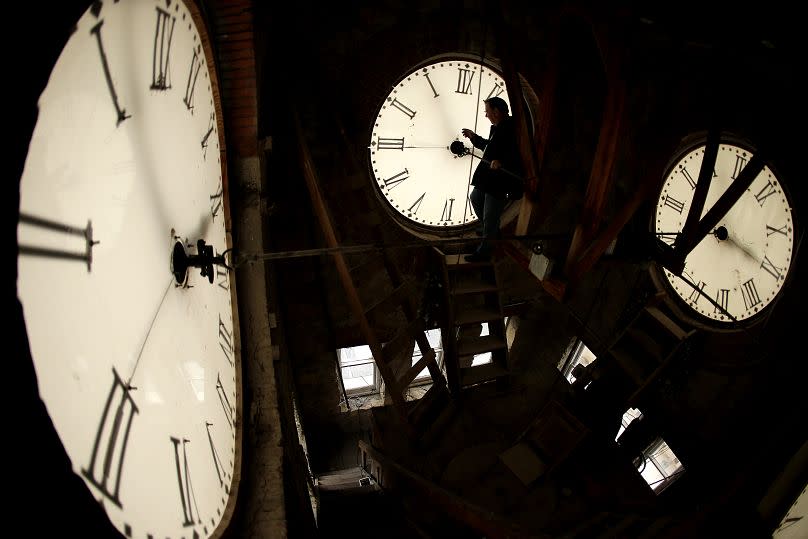Everyone on Earth will lose a second of time in the next few years, but the exact time when this happens is now affected by human-caused climate change.
For the first time in history, world timekeepers may have to consider removing a second from our clocks in a few years because the planet is spinning a little faster than before.
Clocks may have to skip a so-called “negative leap second” around 2029, according to a study published Wednesday in the journal Nature.
Without global warminghowever, this time change would likely occur three years earlier, in 2026.
“This is unprecedented and a major event,” said study lead author Duncan Agnew, a geophysicist at the Scripps Institution of Oceanography at the University of California, San Diego.
“This isn’t a huge change in the Earth’s rotation that would cause a catastrophe or anything, but it’s something worth noting. It’s another indication that we’re in very unusual times.”
How does global warming affect timekeeping?
If it didn’t, the negative leap second would have to come sooner. global warmingthe study says.
“We’re heading for a negative leap second,” said Dennis McCarthy, retired time manager for the U.S. Naval Observatory, who was not part of the research. “It’s a matter of when.”
The Earth is accelerating because its hot liquid core — “a big ball of molten liquid” — is moving in unpredictable ways with changing eddies and flows, Agnew said.
He adds that the core has been triggering an acceleration for about 50 years, but the rapid melting of polar ice since 1990 has masked this effect.
ice melt Changes at both poles of the Earth due to human-induced climate change have slowed down the rotation of the planet somewhat. Less solid ice in the north and south, resulting in meltwater raising sea levels, is moving the planet’s mass towards the equator.
This slows the spin, Agnew said, much like a spinning ice skater slows down as she extends her arms out to her sides.
According to their calculations, if it weren’t for the effect of melting ice, Earth would need this negative leap second in 2026 instead of 2029.
How do we measure time?
Global timekeeping, physics, global power politics, climate changetechnology and two kinds of time.
It takes about 24 hours for the Earth to rotate, but the key word is approximate.
Agnew and Judah Levine, a physicist in the time and frequency division of the National Institute of Standards and Technology, said the Earth has been generally slowing down for thousands of years, and that speed has changed from time to time.
McCarthy said the slowdown was mostly due to the tidal effect of the moon receding.
This didn’t matter until atomic clocks were adopted as the official time standard 55 years ago. These have not slowed down.

This created two versions time – astronomical and atomic – and they did not match. Astronomical time fell 2.5 milliseconds behind atomic time every day. This means that the atomic clock will say it is midnight, and on Earth it will be midnight in less than a second, Agnew said.
The sum of these daily fractions of seconds equaled a full second every few years.
Beginning in 1972, international timekeepers decided to add a “leap second” called Coordinated Universal Time, or UTC, for astronomical time to catch up with atomic time in June or December. Instead of 11:59 and 59 seconds turning into midnight, there would be one more second at 11:59 and 60 seconds.
A negative leap second will skip 11:59:59 and go directly from 11:59 and 58 seconds to midnight.
Between 1972 and 2016, 27 separate leap seconds were added as the Earth slowed down. However, the rate of deceleration was gradually decreasing.
“In 2016 or 2017 or maybe 2018, the rate of deceleration slowed down to the point where the Earth was actually accelerating,” Levine said.
Are these small time adjustments needed?
For decades, astronomers had kept universal and astronomical time together with handy little leap seconds.
But computer system operators said those additions weren’t easy given the technologies the world now relies on. In 2012, some computer systems mishandled leap seconds, causing problems for Reddit, Linux, Qantas Airlines and others, experts said.
“Why should this adjustment be made over time when it causes so many problems?” McCarthy said.
But Russia’s satellite Agnew and McCarthy said the system is based on astronomical time, so eliminating leap seconds would cause problems. Astronomers and others wanted to preserve the system that would add a leap second whenever the difference between atomic and astronomical time approached one second.
In 2022, the world’s timekeepers decided to reduce this possibility by changing the standards for adding or deleting leap seconds starting in the 2030s.
Tech companies like Google and Amazon have unilaterally introduced their own solutions to the leap second problem by gradually adding fractions of a second over the course of a full day, Levine said.
“The fights are so serious because the risks are so small,” Levine said.
Then, instead of adding a leap second, add the “weird” effect of subtraction, Agnew said. McCarthy said it would probably be harder to skip a second because software programs are designed to add time, not reduce it.
McCarthy said the trend toward needing a negative leap second is obvious, but he thinks it has more to do with the Earth becoming rounder due to geological changes from the end of the last second. ice Age.
Three outside scientists said Agnew’s study made sense and his evidence was convincing.
But Levine doesn’t think a negative leap second will actually be needed. He said that there is a general slowing down trend. tide It has been around for centuries and continues, but shorter trends in the Earth’s core come and go.
“This is not a process where the past is a good predictor of the future,” Levine said. “Anyone making long-term predictions about the future is on very, very shaky ground.”